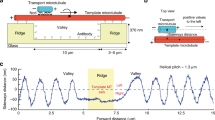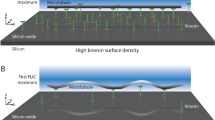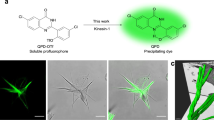Abstract
The dimeric motor protein kinesin-1 walks along microtubules by alternatingly hydrolyzing ATP and moving two motor domains ('heads'). Nanometer-precision single-molecule studies demonstrated that kinesin takes regular 8-nm steps upon hydrolysis of each ATP; however, the intermediate states between steps have not been directly visualized. Here, we employed high-temporal resolution dark-field microscopy to directly visualize the binding and unbinding of kinesin heads to or from microtubules during processive movement. Our observations revealed that upon unbinding from microtubules, the labeled heads were displaced rightward and underwent tethered diffusive movement. Structural and kinetic analyses of wild-type and mutant kinesins with altered neck linker lengths provided evidence that rebinding of the unbound head to the rear-binding site is prohibited by a tension increase in the neck linker and that ATP hydrolysis by the leading head is suppressed when both heads are bound to the microtubule, thereby explaining how the two heads coordinate to move in a hand-over-hand manner.
This is a preview of subscription content, access via your institution
Access options
Subscribe to this journal
Receive 12 print issues and online access
$259.00 per year
only $21.58 per issue
Buy this article
- Purchase on Springer Link
- Instant access to full article PDF
Prices may be subject to local taxes which are calculated during checkout






Similar content being viewed by others
References
Vale, R.D. & Milligan, R.A. The way things move: looking under the hood of molecular motor proteins. Science 288, 88–95 (2000).
Asenjo, A.B., Krohn, N. & Sosa, H. Configuration of the two kinesin motor domains during ATP hydrolysis. Nat. Struct. Biol. 10, 836–842 (2003).
Kaseda, K., Higuchi, H. & Hirose, K. Alternate fast and slow stepping of a heterodimeric kinesin molecule. Nat. Cell Biol. 5, 1079–1082 (2003).
Asbury, C.L., Fehr, A.N. & Block, S.M. Kinesin moves by an asymmetric hand-over-hand mechanism. Science 302, 2130–2134 (2003).
Yildiz, A., Tomishige, M., Vale, R.D. & Selvin, P.R. Kinesin walks hand-over-hand. Science 303, 676–678 (2004).
Svoboda, K., Schmidt, C.F., Schnapp, B.J. & Block, S.M. Direct observation of kinesin stepping by optical trapping interferometry. Nature 365, 721–727 (1993).
Visscher, K., Schnitzer, M.J. & Block, S.M. Single kinesin molecules studied with a molecular force clamp. Nature 400, 184–189 (1999).
Carter, N.J. & Cross, R.A. Mechanics of the kinesin step. Nature 435, 308–312 (2005).
Block, S.M. Kinesin motor mechanics: binding, stepping, tracking, gating, and limping. Biophys. J. 92, 2986–2995 (2007).
Hackney, D.D. Evidence for alternating head catalysis by kinesin during microtubule-stimulated ATP hydrolysis. Proc. Natl. Acad. Sci. USA 91, 6865–6869 (1994).
Ma, Y.-Z. & Taylor, E.W. Interacting head mechanism of microtubule-kinesin ATPase. J. Biol. Chem. 272, 724–730 (1997).
Gilbert, S.P., Moyer, M.L. & Johnson, K.A. Alternating site mechanism of the kinesin ATPase. Biochemistry 37, 792–799 (1998).
Cross, R.A. The kinetic mechanism of kinesin. Trends Biochem. Sci. 29, 301–309 (2004).
Auerbach, S.D. & Johnson, K.A. Alternating site ATPase pathway of rat conventional kinesin. J. Biol. Chem. 280, 37048–37060 (2005).
Hackney, D.D. Processive motor movement. Science 316, 58–59 (2007).
Valentine, M.T. & Gilbert, S.P. To step or not to step? How biochemistry and mechanics influence processivity in Kinesin and Eg5. Curr. Opin. Cell Biol. 19, 75–81 (2007).
Asbury, C.L. Kinesin: world's tiniest biped. Curr. Opin. Cell Biol. 17, 89–97 (2005).
Gennerich, A. & Vale, R.D. Walking the walk: how kinesin and dynein coordinate their steps. Curr. Opin. Cell Biol. 21, 59–67 (2009).
Mori, T., Vale, R.D. & Tomishige, M. How kinesin waits between steps. Nature 450, 750–754 (2007).
Asenjo, A.B. & Sosa, H. A mobile kinesin-head intermediate during the ATP-waiting state. Proc. Natl. Acad. Sci. USA 106, 5657–5662 (2009).
Guydosh, N.R. & Block, S.M. Direct observation of the binding state of the kinesin head to the microtubule. Nature 461, 125–128 (2009).
Yildiz, A., Tomishige, M., Gennerich, A. & Vale, R.D. Intramolecular strain coordinates kinesin stepping behavior along microtubules. Cell 134, 1030–1041 (2008).
Dunn, A.R. & Spudich, J.A. Dynamics of the unbound head during myosin V processive translocation. Nat. Struct. Mol. Biol. 14, 246–248 (2007).
Ueno, H. et al. Simple dark-field microscopy with nanometer spatial precision and microsecond temporal resolution. Biophys. J. 98, 2014–2023 (2010).
Nishikawa, S. et al. Switch between large hand-over-hand and small inchworm-like steps in myosin VI. Cell 142, 879–888 (2010).
Tomishige, M., Stuurman, N. & Vale, R.D. Single-molecule observations of neck linker conformational changes in the kinesin motor protein. Nat. Struct. Mol. Biol. 13, 887–894 (2006).
Cao, L. et al. The structure of apo-kinesin bound to tubulin links the nucleotide cycle to movement. Nat. Commun. 5, 5364 (2014).
Hyeon, C. & Onuchic, J.N. Mechanical control of the directional stepping dynamics of the kinesin motor. Proc. Natl. Acad. Sci. USA 104, 17382–17387 (2007).
Hua, W., Chung, J. & Gelles, J. Distinguishing inchworm and hand-over-hand processive kinesin movement by neck rotation measurements. Science 295, 844–848 (2002).
Gutiérrez-Medina, B., Fehr, A.N. & Block, S.M. Direct measurements of kinesin torsional properties reveal flexible domains and occasional stalk reversals during stepping. Proc. Natl. Acad. Sci. USA 106, 17007–17012 (2009).
Verbrugge, S., Lansky, Z. & Peterman, E.J.G. Kinesin's step dissected with single-motor FRET. Proc. Natl. Acad. Sci. USA 106, 17741–17746 (2009).
Clancy, B.E., Behnke-Parks, W.M., Andreasson, J.O.L., Rosenfeld, S.S. & Block, S.M. A universal pathway for kinesin stepping. Nat. Struct. Mol. Biol. 18, 1020–1027 (2011).
Rice, S. et al. A structural change in the kinesin motor protein that drives motility. Nature 402, 778–784 (1999).
Hyeon, C. & Onuchic, J.N. A structural perspective on the dynamics of kinesin motors. Biophys. J. 101, 2749–2759 (2011).
Milic, B., Andreasson, J.O.L., Hancock, W.O. & Block, S.M. Kinesin processivity is gated by phosphate release. Proc. Natl. Acad. Sci. USA 111, 14136–14140 (2014).
Schnitzer, M.J. & Block, S.M. Kinesin hydrolyses one ATP per 8-nm step. Nature 388, 386–390 (1997).
Hua, W., Young, E.C., Fleming, M.L. & Gelles, J. Coupling of kinesin steps to ATP hydrolysis. Nature 388, 390–393 (1997).
Hackney, D.D., Stock, M.F., Moore, J. & Patterson, R.A. Modulation of kinesin half-site ADP release and kinetic processivity by a spacer between the head groups. Biochemistry 42, 12011–12018 (2003).
Shastry, S. & Hancock, W.O. Neck linker length determines the degree of processivity in kinesin-1 and kinesin-2 motors. Curr. Biol. 20, 939–943 (2010).
Alonso, M.C. et al. An ATP gate controls tubulin binding by the tethered head of kinesin-1. Science 316, 120–123 (2007).
Hackney, D.D. The tethered motor domain of a kinesin-microtubule complex catalyzes reversible synthesis of bound ATP. Proc. Natl. Acad. Sci. USA 102, 18338–18343 (2005).
Kikkawa, M. The role of microtubules in processive kinesin movement. Trends Cell Biol. 18, 128–135 (2008).
Hancock, W.O. & Howard, J. Kinesin's processivity results from mechanical and chemical coordination between the ATP hydrolysis cycles of the two motor domains. Proc. Natl. Acad. Sci. USA 96, 13147–13152 (1999).
Uemura, S. & Ishiwata, S. Loading direction regulates the affinity of ADP for kinesin. Nat. Struct. Biol. 10, 308–311 (2003).
Rosenfeld, S.S., Fordyce, P.M., Jefferson, G.M., King, P.H. & Block, S.M. Stepping and stretching. How kinesin uses internal strain to walk processively. J. Biol. Chem. 278, 18550–18556 (2003).
Klumpp, L.M., Hoenger, A. & Gilbert, S.P. Kinesin's second step. Proc. Natl. Acad. Sci. USA 101, 3444–3449 (2004).
Guydosh, N.R. & Block, S.M. Backsteps induced by nucleotide analogs suggest the front head of kinesin is gated by strain. Proc. Natl. Acad. Sci. USA 103, 8054–8059 (2006).
Hyeon, C. & Onuchic, J.N. Internal strain regulates the nucleotide binding site of the kinesin leading head. Proc. Natl. Acad. Sci. USA 104, 2175–2180 (2007).
Andreasson, J.O.L. et al. Examining kinesin processivity within a general gating framework. eLife 4, e07403 (2015).
Dogan, M.Y., Can, S., Cleary, F.B., Purde, V. & Yildiz, A. Kinesin's front head is gated by the backward orientation of its neck linker. Cell Reports 10, 1967–1973 (2015).
Kerssemakers, J.W. et al. Assembly dynamics of microtubules at molecular resolution. Nature 442, 709–712 (2006).
Acknowledgements
We thank M. Nakajima for support with cloning, M. Tanigawara for support with the preparation of colloidal gold and R. Vale for useful comments on the manuscript. We also acknowledge that the neck-linker mutants were first established by M.T. with R. Vale. H.I. is supported by Research Fellowships for Young Scientists from the Japan Society for the Promotion of Science. M.T. (no. 24370063), R.I. (no. 24370062, no. 26104507) and H.N. (no. 25251016) are supported by Grants-in-Aid for Scientific Research from the Ministry of Education, Culture, Sports, Science and Technology.
Author information
Authors and Affiliations
Contributions
M.T. and H.I. conceived and designed the experiments; R.I. constructed and refined the microscope with H.N.; H.I. performed the experiments with R.I.; Y.N. performed the experiments added in the revision; H.I., R.I. and Y.N. analyzed the data and prepared the figures; and M.T. wrote and R.I. edited the manuscript.
Corresponding author
Ethics declarations
Competing interests
The authors declare no competing financial interests.
Supplementary information
Supplementary Text and Figures
Supplementary Results, Supplementary Figures 1–12 (PDF 2962 kb)
Rights and permissions
About this article
Cite this article
Isojima, H., Iino, R., Niitani, Y. et al. Direct observation of intermediate states during the stepping motion of kinesin-1. Nat Chem Biol 12, 290–297 (2016). https://doi.org/10.1038/nchembio.2028
Received:
Accepted:
Published:
Issue Date:
DOI: https://doi.org/10.1038/nchembio.2028
This article is cited by
-
A Model for Chemomechanical Coupling of Kinesin-3 Motor
Cellular and Molecular Bioengineering (2024)
-
Powerful microscope captures motor proteins in unprecedented detail
Nature (2023)
-
Spatial and temporal dynamics of ATP synthase from mitochondria toward the cell surface
Communications Biology (2023)
-
Scattering imaging of biomolecules with metallic nanoparticles: localization precision, imaging speed, and multicolor imaging capability
Optical Review (2022)
-
Small stepping motion of processive dynein revealed by load-free high-speed single-particle tracking
Scientific Reports (2020)



